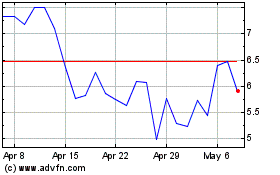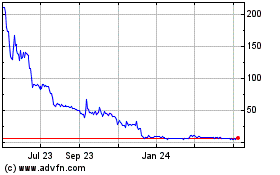ZyVersa Therapeutics, Inc. (Nasdaq: ZVSA, or “ZyVersa”), a clinical
stage specialty biopharmaceutical company developing first-in-class
drugs for treatment of inflammatory and renal diseases, highlights
data published in the peer-reviewed journal, Aging Cell,
demonstrating that obesity in older adults or prolonged duration of
obesity in the younger population resulted in inflammation and
suppression of neurotrophic/neuroprotective factors in the brain,
indicating that age and duration of obesity are critical risk
factors for neurodegenerative diseases.
“With IC 100’s demonstrated penetration of the brain and key
organs affected by obesity, such as heart, kidney, and liver, and
its unique anti-inflammatory mechanism of action, IC 100 has
potential to control the CNS and systemic inflammation of obesity
and attenuate development and/or progression of associated
comorbidities, such as Parkinson’s and heart diseases,” stated
Stephen C. Glover, ZyVersa’s Co-founder, Chairman, CEO, and
President. “The potential for IC 100 to attenuate the damaging
neuroinflammation leading to Parkinson’s disease is supported by
data from a recently completed in vitro study demonstrating IC
100’smechanistic proof-of-concept in this indication. The study was
funded by the Michael J. Fox Foundation and conducted by
researchers at the University of Miami Miller School of Medicine.
Future Parkinson’s animal model studies are planned.”
The paper titled, Age and duration of obesity modulate the
inflammatory response and expression of neuroprotective factors in
mammalian female brain, summarizes research conducted in a
diet-induced obesity (DIO) mouse model. To characterize the effects
of age and duration of obesity, adolescent (5 weeks old) and mature
adult (14 weeks old) female mice were fed a high fat diet (HFD) for
either 13 or 26 weeks. Age-matched control mice were fed a standard
diet. Key findings:
- HFD induced a typical obesity
phenotype in mice independent of age and duration
- Significant weight gain, increase in
fat cell size, and subcutaneous adipose tissue inflammation
- At 13 weeks, adolescent obese mice
developed a limited inflammatory response in the hypothalamus, but
when the duration was extended to 26 weeks:
- A systemic inflammatory response was
demonstrated
- Inflammation was demonstrated in
visceral adipose tissue, which is responsible for comorbidities,
and in all three brain regions studied (hypothalamus, hippocampus,
and cerebral cortex)
- Neurotrophic/neuroprotective factors
were suppressed
- Microgliosis and astrogliosis
developed, which are associated with brain damage
- Unlike adolescent mice at 13 weeks,
mature adult mice demonstrated systemic inflammation and
suppression of neurotrophic/neuroprotective factors in all three
brain regions studied. This was sustained through the 26-week
study, suggesting that advanced age may negatively affect obesity
outcomes earlier than in younger individuals
“From the translational perspective, the findings of the present
study highlight the importance of early interventions to combat
obesity and, thus, to avoid the associated comorbidities,”
concluded the authors.
About Inflammasome ASC Inhibitor IC 100
IC 100 is a novel humanized IgG4 monoclonal antibody that
inhibits the inflammasome adaptor protein ASC. IC 100 was designed
to attenuate both initiation and perpetuation of the inflammatory
response. It does so by binding to a specific region of the ASC
component of multiple types of inflammasomes, including NLRP1,
NLRP2, NLRP3, NLRC4, AIM2, and Pyrin. Intracellularly, IC 100 binds
to ASC monomers, inhibiting inflammasome formation, thereby
blocking activation of IL-1β early in the inflammatory cascade. IC
100 also binds to ASC in ASC Specks, both intracellularly and
extracellularly, further blocking activation of IL-1β and the
perpetuation of the inflammatory response that is pathogenic in
inflammatory diseases. Because active cytokines amplify adaptive
immunity through various mechanisms, IC 100, by attenuating
cytokine activation, also attenuates the adaptive immune response.
The lead indication for IC 100 is obesity and its associated
metabolic complications. To review a white paper summarizing the
mechanism of action and preclinical data for IC 100, Click
Here.
About ZyVersa Therapeutics, Inc.
ZyVersa (Nasdaq: ZVSA) is a clinical stage specialty
biopharmaceutical company leveraging advanced proprietary
technologies to develop first-in-class drugs for patients with
inflammatory or kidney diseases with high unmet medical needs. We
are well positioned in the rapidly emerging inflammasome space with
a highly differentiated monoclonal antibody, Inflammasome ASC
Inhibitor IC 100, and in kidney disease with phase 2 Cholesterol
Efflux MediatorTM VAR 200. The lead indication for IC 100 is
obesity and its associated metabolic complications, and for VAR
200, focal segmental glomerulosclerosis (FSGS). Each therapeutic
area offers a “pipeline within a product,” with potential for
numerous indications. The total accessible market is over $100
billion. For more information, please visit www.zyversa.com.
Cautionary Statement Regarding Forward-Looking
Statements
Certain statements contained in this press release regarding
matters that are not historical facts, are forward-looking
statements within the meaning of Section 21E of the Securities
Exchange Act of 1934, as amended, and the Private Securities
Litigation Reform Act of 1995. These include statements regarding
management’s intentions, plans, beliefs, expectations, or forecasts
for the future, and, therefore, you are cautioned not to place
undue reliance on them. No forward-looking statement can be
guaranteed, and actual results may differ materially from those
projected. ZyVersa Therapeutics, Inc (“ZyVersa”) uses words such as
“anticipates,” “believes,” “plans,” “expects,” “projects,”
“future,” “intends,” “may,” “will,” “should,” “could,” “estimates,”
“predicts,” “potential,” “continue,” “guidance,” and similar
expressions to identify these forward-looking statements that are
intended to be covered by the safe-harbor provisions. Such
forward-looking statements are based on ZyVersa’s expectations and
involve risks and uncertainties; consequently, actual results may
differ materially from those expressed or implied in the statements
due to a number of factors, including ZyVersa’s plans to develop
and commercialize its product candidates, the timing of initiation
of ZyVersa’s planned preclinical and clinical trials; the timing of
the availability of data from ZyVersa’s preclinical and clinical
trials; the timing of any planned investigational new drug
application or new drug application; ZyVersa’s plans to research,
develop, and commercialize its current and future product
candidates; the clinical utility, potential benefits and market
acceptance of ZyVersa’s product candidates; ZyVersa’s
commercialization, marketing and manufacturing capabilities and
strategy; ZyVersa’s ability to protect its intellectual property
position; and ZyVersa’s estimates regarding future revenue,
expenses, capital requirements and need for additional
financing.
New factors emerge from time-to-time, and it is not possible for
ZyVersa to predict all such factors, nor can ZyVersa assess the
impact of each such factor on the business or the extent to which
any factor, or combination of factors, may cause actual results to
differ materially from those contained in any forward-looking
statements. Forward-looking statements included in this press
release are based on information available to ZyVersa as of the
date of this press release. ZyVersa disclaims any obligation to
update such forward-looking statements to reflect events or
circumstances after the date of this press release, except as
required by applicable law.
This press release does not constitute an offer to sell, or the
solicitation of an offer to buy, any securities.
Corporate, Media, and IR Contact:Karen
CashmereChief Commercial
Officerkcashmere@zyversa.com786-251-9641
ZyVersa Therapeutics (NASDAQ:ZVSA)
Historical Stock Chart
From Jan 2025 to Feb 2025

ZyVersa Therapeutics (NASDAQ:ZVSA)
Historical Stock Chart
From Feb 2024 to Feb 2025
